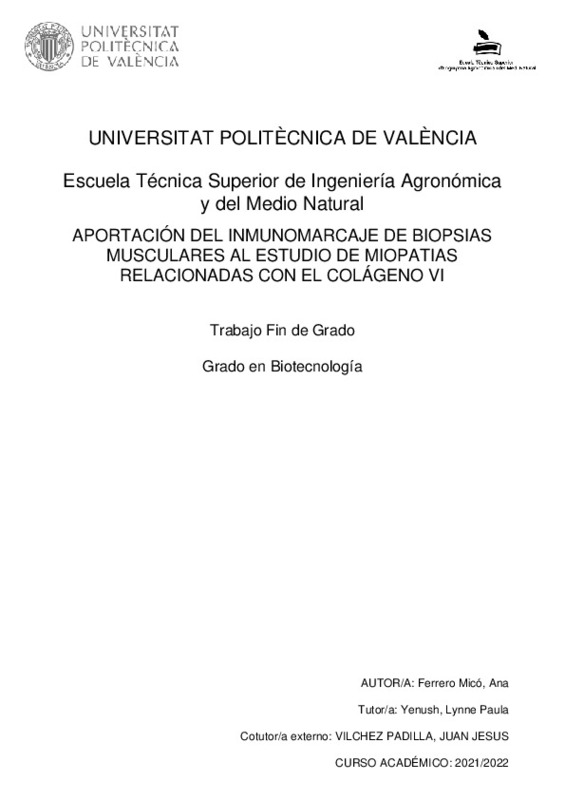JavaScript is disabled for your browser. Some features of this site may not work without it.
Buscar en RiuNet
Listar
Mi cuenta
Estadísticas
Ayuda RiuNet
Admin. UPV
Aportación del inmunomarcaje de biopsias musculares al estudio de miopatias relacionadas con el colágeno VI
Mostrar el registro sencillo del ítem
Ficheros en el ítem
| dc.contributor.advisor | Yenush, Lynne Paula
|
es_ES |
| dc.contributor.advisor | Vílchez Padilla, Juan Jesús
|
es_ES |
| dc.contributor.author | Ferrero Micó, Ana
|
es_ES |
| dc.date.accessioned | 2022-07-13T13:26:15Z | |
| dc.date.available | 2022-07-13T13:26:15Z | |
| dc.date.created | 2022-06-27 | |
| dc.date.issued | 2022-07-13 | es_ES |
| dc.identifier.uri | http://hdl.handle.net/10251/184105 | |
| dc.description.abstract | [ES] A partir de muestras de pacientes con distrofias musculares, se pretende llevar a cabo la detección del déficit de colágeno tipo VI (COL VI) que las provoca. Hasta el momento, se han utilizado métodos de inmunomarcaje para su diagnóstico, pero en ocasiones el resultado ha sido inconcluyente. Además, se ha realizado el estudio genético mediante estudios de secuenciación masiva (NGS), pero, debido al alto porcentaje de variantes encontradas en los genes del COL VI, junto con la herencia dominante, es necesario corroborar con el inmunomarcaje que hay alteración o déficit en la muestra del paciente y así poder afirmar que la variante es patogénica. En los casos en los que el fenotipo indique una posible alteración del colágeno y los estudios de exomas no hayan encontrado variantes, las técnicas de inmunomarcaje guiaran el estudio de RNA seq para buscar si hay presencia de mutaciones intrónicas. Por lo tanto, lo que se pretende con nuestro trabajo, es modificar las técnicas de inmunomarcaje para mejorar la sensibilidad de la detección de las proteínas mutadas, y afrontar el abordaje de forma integral de los métodos morfológicos, moleculares y clínicos. Para ello, se procede a hacer una división en 4 grupos de los pacientes: un grupo control, un grupo con mutación y con el fenotipo correspondiente, un grupo con mutación, pero sin fenotipo concluyente y otro grupo con el fenotipo correspondiente del espectro del COL VI, pero sin mutación detectada mediante NGS. | es_ES |
| dc.description.abstract | [EN] From samples of patients with muscular dystrophies, it is intended to carry out the detection of type VI collagen deficiency (COL VI) that causes them. Until now, immunolabelling methods have been used for its diagnosis, but sometimes the results have been inconclusive. In addition, the genetic study has been carried out by means of massive sequencing studies (NGS), but, due to the high percentage of variants found in the COL VI genes, together with the dominant inheritance, it is necessary to corroborate with immunolabeling that there is an alteration or deficit in the patient's sample and thus be able to affirm that the variant is pathogenic. In cases where the phenotype indicates a possible collagen alteration and exome studies have not found variants, immunolabeling techniques will guide the RNA seq study to search for the presence of intronic mutations. Therefore, what is intended with our work is to modify the immunolabeling techniques to improve the sensitivity of the detection of mutated proteins, and address the comprehensive approach of morphological, molecular, and clinical methods. For this, the patients are divided into 4 groups: a control group, a group with a mutation and with the corresponding phenotype, a group with a mutation, but without a conclusive phenotype, and another group with the corresponding phenotype of the collagen VI spectrum, but no mutation detected by NGS. | es_ES |
| dc.format.extent | 39 | es_ES |
| dc.language | Español | es_ES |
| dc.publisher | Universitat Politècnica de València | es_ES |
| dc.rights | Reconocimiento (by) | es_ES |
| dc.subject | Colágeno VI | es_ES |
| dc.subject | Laminina | es_ES |
| dc.subject | Mutaciones | es_ES |
| dc.subject | Inmunomarcaje | es_ES |
| dc.subject | Miopatías | es_ES |
| dc.subject | Collagen VI | es_ES |
| dc.subject | Laminin | es_ES |
| dc.subject | Mutations | es_ES |
| dc.subject | Inmunolabelling | es_ES |
| dc.subject | Myopathyies | es_ES |
| dc.subject.classification | BIOQUIMICA Y BIOLOGIA MOLECULAR | es_ES |
| dc.subject.other | Grado en Biotecnología-Grau en Biotecnologia | es_ES |
| dc.title | Aportación del inmunomarcaje de biopsias musculares al estudio de miopatias relacionadas con el colágeno VI | es_ES |
| dc.title.alternative | Contribution of immunomarking of muscle biopsies to the study of myopathies related to collagen VI | es_ES |
| dc.title.alternative | Aportació del inmunomarcatge de biopsies musculars al estudi de miopaties relacionades amb el colàgen VI | es_ES |
| dc.type | Proyecto/Trabajo fin de carrera/grado | es_ES |
| dc.rights.accessRights | Abierto | es_ES |
| dc.contributor.affiliation | Universitat Politècnica de València. Departamento de Biotecnología - Departament de Biotecnologia | es_ES |
| dc.contributor.affiliation | Universitat Politècnica de València. Escuela Técnica Superior de Ingeniería Agronómica y del Medio Natural - Escola Tècnica Superior d'Enginyeria Agronòmica i del Medi Natural | es_ES |
| dc.description.bibliographicCitation | Ferrero Micó, A. (2022). Aportación del inmunomarcaje de biopsias musculares al estudio de miopatias relacionadas con el colágeno VI. Universitat Politècnica de València. http://hdl.handle.net/10251/184105 | es_ES |
| dc.description.accrualMethod | TFGM | es_ES |
| dc.relation.pasarela | TFGM\150374 | es_ES |
Este ítem aparece en la(s) siguiente(s) colección(ones)
-
ETSIAMN - Trabajos académicos [3541]
Escuela Técnica Superior de Ingeniería Agronómica y del Medio Natural






